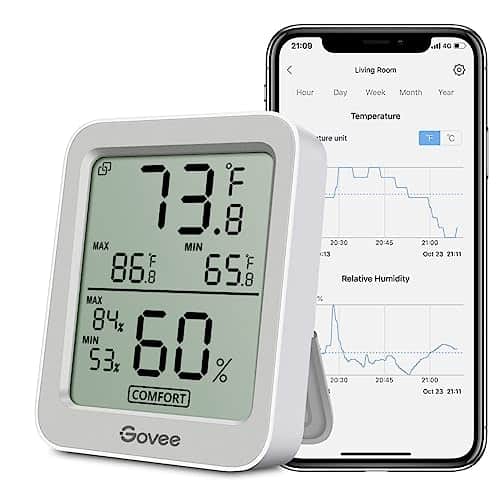


STE2 LITE: Remote Temperature Monitoring with Email Alerts – HWg Video Overview HV64
Choose the Right Smart Temperature Sensor
Research various smart temperature sensors available in the market. Compare their temperature range, ensuring the sensor can measure the temperatures you are interested in, from freezing conditions to high heat, like the Ecobee SmartSensor, which works effectively between -20°F to 125°F. Evaluate the accuracy of the sensors; look for those boasting an accuracy of ±1°F or better, such as the Netatmo Weather Station.
Examine connectivity options that fit your lifestyle. Determine whether you prefer sensors that connect via Wi-Fi, like the Nest Temperature Sensor, or Bluetooth options, which may be better for localized use. Check for compatibility with existing smart home systems, ensuring it integrates seamlessly with platforms like Google Assistant or Apple HomeKit, allowing for smooth automation and control.



Install the Smart Temperature Sensor
Read the manufacturer’s instructions carefully. Identify the recommended installation height and location for optimal performance. Choose a spot away from direct sunlight, heating vents, or other temperature-altering elements. Mount the sensor securely, ensuring that it is not obstructed by furniture or other objects that could interfere with accurate readings. Regularly check the sensor’s position to maintain its effectiveness.
Download the Companion App
Search for the corresponding mobile application in your device’s app store by entering the name of your smart temperature sensor. Download and install the app on your smartphone or tablet. Open the app and follow the on-screen instructions to set up your account. Once set up, connect the app to your sensor to begin controlling and monitoring the temperature remotely.
Connect the Sensor to Your Wi-Fi Network
Open the app on your smartphone or tablet. Follow the on-screen prompts to begin the connection process for your smart temperature sensor. When asked, select your home Wi-Fi network from the list and enter your Wi-Fi password. Confirm the connection by tapping the appropriate button, allowing the sensor to link with your network for seamless remote monitoring.
Set Up Notifications and Alerts
Access the app’s settings menu and locate the notifications section. Select the option to customize alerts for temperature fluctuations. Set your desired temperature range by inputting your minimum and maximum thresholds. Enable notifications to receive instant alerts whenever the temperature goes outside of this range, ensuring prompt responses to any potential issues.
Integrate with Smart Home Systems
Connect the smart temperature sensor to your home Wi-Fi network following the manufacturer’s instructions. Access the settings in the associated mobile app and select the option for smart home integration. Choose either Amazon Alexa or Google Home based on your preference, then follow the prompts to link your accounts. Enable voice control by giving commands such as “Set the temperature to 72 degrees” and create automated routines for temperature adjustments throughout the day.
Calibrate the Temperature Sensor
Calibrate the temperature sensor by first obtaining a known accurate thermometer. Place the temperature sensor and the accurate thermometer side by side in a controlled environment where the temperature is stable. Record the readings from both devices after they have stabilized. Adjust the settings on the temperature sensor according to the discrepancies between its readings and the accurate thermometer’s measurements to ensure accurate results in future use.
Monitor Temperature Remotely
Open the app and navigate to the temperature monitoring section. Select the sensor you wish to monitor to view real-time data on the current temperature readings. Access the historical records by tapping on the appropriate tab, allowing for easy analysis of temperature trends over time. Utilize filters or date ranges to focus on specific time periods for a more detailed review of the data.
Maintain Your Device
Regularly check the smart temperature sensor for any signs of wear or malfunction. Change the batteries if the sensor is not functioning properly or if the battery indicator shows low power. Keep the sensor clean by wiping it gently with a soft, dry cloth, and ensure there are no obstructions, such as dust or furniture, blocking its view. For example, if the sensor is placed near a vent, reposition it to get more accurate readings.
Review and Adjust Settings as Necessary
Periodically review your sensor settings and alerts. Examine the current configurations to ensure they align with any changes in your environment or requirements. Adjust the sensitivity levels and notification thresholds as needed based on your observations and experiences. Make these updates regularly to maintain optimal performance and responsiveness of your sensors.
Benefits of Remote Monitoring
In conclusion, by implementing the outlined steps for remote temperature monitoring with smart technology, individuals can greatly improve their management of temperature-sensitive environments. This proactive approach not only ensures optimal conditions but also provides peace of mind through real-time data access and alerts. Embracing these innovative tools ultimately leads to more efficient and effective temperature control, highlighting the benefits of modern technological solutions in everyday life.
Essential Equipment List


Optimize Your Monitoring
Step-by-Step Guide to Effectively Utilize Your Smart Temperature Monitoring System
- Choose the Right Device: Begin by selecting a smart temperature monitoring device that fits your needs, such as a connected thermometer or monitoring system suitable for home or office use
- Install the App: Download the corresponding mobile app that connects to the smart temperature monitoring device. This app will allow users to monitor temperature readings and receive alerts on their smartphones
- Set Up the Device: Follow the manufacturer’s instructions to properly set up the smart temperature monitoring device. This may involve connecting it to Wi-Fi, placing it in the desired location, and calibrating it for accurate readings
- Configure Alerts and Settings: Use the app to configure temperature thresholds and alerts. Users can set notifications to be alerted if the temperature goes above or below specific levels, ensuring they can respond promptly
- Monitor and Analyze Data: Regularly check the app to monitor real-time temperature data and review historical trends. This information can help users make informed decisions about temperature control and maintenance in their environment
Everything You Need to Know About Smart Temperature Monitoring
When implementing smart temperature monitoring, several common challenges may arise. First, technical integration can be complex, as it often requires compatibility between new monitoring devices and existing systems. Second, data accuracy is crucial; any sensor malfunctions or calibration issues can lead to incorrect temperature readings, which may compromise safety and quality control.
Third, there are often concerns about cybersecurity and data privacy, as smart temperature monitoring systems can be vulnerable to hacking or unauthorized access. Fourth, managing large amounts of data generated by these systems can be overwhelming, necessitating advanced data analytics capabilities for effective monitoring and decision-making.
Finally, user training and adoption can pose challenges, as employees may need to become familiar with new technologies and processes, which can slow down the implementation process. Overcoming these challenges often requires careful planning, investment in technology, and effective training programs.
Smart temperature monitoring refers to the use of advanced technology to continuously track and manage temperature in various environments, such as homes, offices, industrial settings, or specific storage facilities like pharmaceuticals and food warehouses. This system typically involves sensors that measure temperature in real-time and transmit this data to a central system or cloud platform.
Typically, smart temperature monitoring works through a few key components:
- Sensors: These devices, which can be installed in various locations, detect the ambient temperature and sometimes even humidity levels.
- Connectivity: The sensors are usually equipped with wireless technology (like Wi-Fi, Bluetooth, or Zigbee) to send data to a centralized platform, which could be a smartphone app, web interface, or a dedicated monitoring system.
- Data Analysis: The collected data is analyzed to provide insights and alerts regarding temperature conditions. Some systems may employ algorithms to predict trends or identify anomalies.
- Notifications: Users receive alerts via notifications or emails if the temperature deviates from predetermined thresholds, allowing for immediate action to prevent damage or spoilage.
- Integration: Smart temperature monitoring systems can often integrate with other smart home or business systems, enabling automated responses such as adjusting HVAC systems to maintain optimal conditions.
Overall, this technology enhances efficiency, ensures safety, and helps in compliance with regulatory standards in sensitive environments.



Leave a Reply